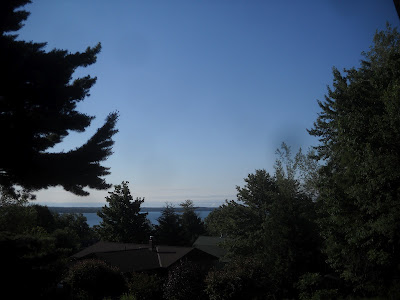 |
| LUPINES |
 |
| COULD I PASS FOR A BLACK FLAT COAT RETRIEVER? |
Friday, 8:00 AM. 66 degrees F, wind SW, calm. The sky is mostly overcast with high gray clouds, the humidity is 80%, and the barometer predicts rain. Yesterday afternoon we had thundershowers, and some pea-sized hail. It is a nice enough morning at present.
The lupines (
Lupinus perennis) are in full bloom all around the area and the earliest to open are now setting seed. They will be past their peak shortly. Lupines get their genus name from the latin name for wolf,
lupus, because it was once thought that since they grew in poor soil the plants must “wolf” the soil nutrients, which they do not. Lupines are only an indicator of infertile soils, and since they are legumes they actually add nitrogen to the soil they grow in.. They are a real show here, and could be a major tourist attraction if their annual blooming date was strictly reliable, which it is not, but can vary by a week or more, depending upon the weather. Our lupines look like they are mostly the native lupine but local heritage says they were introduced from the Bayfield flower farms early in the 1900’s. I think the story is more complicated than that as the wild lupine is common in Bayfield County in the oak barrens, and may have migrated from there over the years, and possibly these plants have mixed with horticultural selections of the native lupine grown by the flower farms.
In any case it is a complicated history, and the USDA and the Wisconsin sources are not particularly helpful. Our plants are mostly deep blue with some white and pink individuals and many individual flowers have white throats, and the native plants have pretty much that range of color variability. Ours may have been horticultural color selections that escaped back into native populations, enriching their color palette. I have seen these plants all along the southern Lake Superior shoreline and northern Lake Michigan dunes, from Duluth to at least the Mackinac Bridge, so if they are not technically native they might as well be considered such. But, native or not, they are beautiful, dependable, and a joy to see. I have seen the Texas bluebonnets in full bloom (also lupines but a different, and much shorter, species) and I think ours are every bit as much of an attraction.
If I were more of a botanical sleuth I would try to really figure this conundrum out, and maybe I will get into it in greater depth at some future time. Photos really do not do the lupine display justice, as they often occur in huge fields which don't seem to have much of an impact in a photograph, and they usually appear in patches large and small along the roadside, like pearls on a string, or more like charms on a bracelet, so their aesthetic impact is much greater than that depicted in a picture. Right now they are in bloom along state Hwy 13 from Ashland all the way to Red Cliff and beyond along the south shore, and east and west along US Hwy. 2.
There will be no blogs for a few days as Joan, Buddy and I are traveling; first to a big AKC flat coat retriever meet in Manitowoc (daughter Greta has her coal black flat coat bitch, Raven, entered in several events), then on to Oconomowoc to visit old friends Bill and Allene and finally to an Urban Forestry Council meeting at the University in Stevens Point. Buddy had better behave himself, as the flat coat people may not appreciate an English pointer intruding on their turf. Maybe we should dye him black for the next few days. Guess he will have to stay in the truck.































































